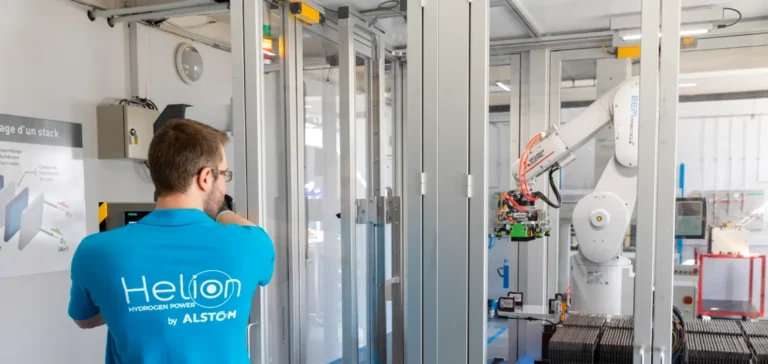The global energy sector faces a major challenge: integrating intermittent renewable energies while ensuring grid stability. Wind and solar, although crucial for the energy transition, are not constant and can lead to periods of overproduction or shortages. In this context, Power-to-Hydrogen-to-Power (PtP) technology emerges as a promising solution for storing excess electricity in the form of hydrogen, then converting it back into energy. However, several economic and technical challenges must be overcome to make this technology viable at scale.
The Principle of Power-to-Hydrogen-to-Power (PtP) Technology
The PtP concept is based on two main steps: electrolysis of water to produce hydrogen from excess electricity, and conversion of this hydrogen into electricity via a fuel cell or gas turbine. Electrolysis uses excess electricity to split water into oxygen and hydrogen. This hydrogen can then be stored as a gas in high-pressure tanks or as a liquid at very low temperatures. The stored hydrogen can be used in a fuel cell to produce electricity when needed, or in a gas turbine as an alternative to conventional thermal power plants.
Efficiency of PtP Technology
The efficiency of PtP technology varies depending on the components used. The electrolyzer, which splits water into oxygen and hydrogen, has an efficiency ranging from 60% to 79% depending on the technology used. Proton Exchange Membrane (PEM) electrolyzers are typically more expensive but offer higher efficiencies, while alkaline electrolyzers, although cheaper, have lower efficiencies ranging from 48% to 70%. Therefore, this first conversion step is relatively efficient, but still inferior to other storage technologies, such as lithium-ion batteries.
The conversion of hydrogen into electricity via fuel cells or gas turbines suffers an additional loss in efficiency. Fuel cell efficiencies range from 45% to 60%, while gas turbines offer efficiencies of around 35% to 48%. Consequently, the entire Power-to-Hydrogen-to-Power process can have an overall efficiency ranging from 27% to 33%, making it less competitive compared to other short-term energy storage forms, such as lithium-ion batteries or pumped hydro storage.
The Benefits of PtP for Managing Energy Production Fluctuations
One of the main advantages of PtP technology is its ability to store electricity over the long term. Unlike lithium-ion batteries, which are more suited for short-term energy storage (a few hours to a few days), hydrogen can be stored for much longer periods, ranging from several weeks to several months. This long-duration storage could help address periods of low renewable energy production, such as windless days or cloudy periods that limit the effectiveness of solar panels.
In Germany, for example, wind energy production can drop significantly during the winter, particularly during the “dunkelflaute” season, where weather conditions make wind energy almost useless. During this period, hydrogen storage could provide a stable energy source to power the grid. According to a study by the International Renewable Energy Agency (IRENA), Germany could integrate up to 7% of its annual energy consumption into PtP systems by 2030, thus contributing to grid resilience.
The Geopolitical and Economic Implications of Hydrogen Storage
The increase in hydrogen production and the storage of energy as hydrogen also brings geopolitical advantages. Hydrogen can be produced locally, reducing reliance on fossil fuel imports. This is a major strategic issue for countries seeking to diversify their energy sources, reduce their carbon footprint, and ensure energy independence. China, for example, plans to invest heavily in hydrogen production infrastructure to support its energy transition and secure its long-term energy supply.
However, the production costs of hydrogen via electrolysis are still high. The cost of producing one kilowatt-hour (kWh) of energy from PtP ranges from $0.35 to $0.55 per kWh, depending on the technology used and the location of production. This cost is still higher than that of energy production from natural gas or coal, but it could decrease as technology develops and production scales up. Experts estimate that as investments increase and production standardizes, the cost of electricity from hydrogen could decrease by 30% to 50% by 2030.
The Economic Viability of PtP Technology
The cost of PtP systems, which include electrolyzers and gas turbines, is also a barrier to large-scale adoption. Currently, hydrogen storage installations are much more expensive than alternative technologies. For example, the installation cost of a high-capacity electrolyzer is estimated at around $300 per kWh, which is much higher than the production cost of lithium-ion batteries (around $100 to $300 per kWh). In addition, the infrastructure needed to transport and store hydrogen (high-pressure tanks, pipelines) further increases the total system cost.
However, the long-term profitability of PtP could become more competitive if hydrogen storage becomes more widespread. Pilot projects in countries such as Germany, the UK, and the US are showing positive signs. For example, a pilot project in Germany, funded by the EU, has shown that a large-scale PtP solution could reduce costs by 15% to 20% from the third generation of systems, making this technology more economically viable in the long term.
International Projects and the Viability of PtP
In several countries, pilot projects have been launched to test the viability of PtP technology on a large scale. In Belgium, for example, a 10 MW hydrogen production and storage project is expected to be completed by 2025. This project aims to demonstrate the effectiveness of hydrogen as a long-term energy storage solution. In France, several studies show that hydrogen could cover about 10% of electricity needs by 2035, through a combination of PtP systems and other storage technologies.
In Asia, Japan and South Korea are investing in hydrogen production infrastructure to diversify their energy sources. China has launched an ambitious “hydrogen gas network” project, aiming to connect several regions to distribute low-cost hydrogen and increase the share of hydrogen in the country’s energy mix.






















